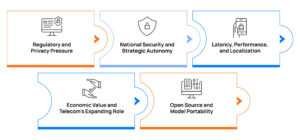Last updated on February 9, 2018
Most of the organizations are going through a transition phase where use of technology in business operations has become mandatory. Major reason is – number of ‘smart’ and connected devices has rapidly grown along with huge spike in usage of mobile/digital traffic. As per Gartner, 20.8 billion connected things will be used worldwide in 2020.
Currently, amount of data to process is proportionately generating by growing number of devices. Additionally, due to technology advancements like video calling, live videos, etc. most of the data traffic is occupied with video content.
Many companies now started to realize the importance of data which they can use for analysis purpose to gain competitive advantage and stay ahead in market. Due to surge of data, technology innovations like Artificial Intelligence, Machine Learning, Internet of Things and Blockchain have emerged and disrupting every industry.
Increases number of devices and demand for video data over internet are creating major challenges for communication service providers (CSP). To keep up in competitive race within CSPs, all are enhancing their technology landscape and investing in future infrastructure. Mainly, there are two ways CSPs can stay on top of market, introduce new services keeping Capital expenditure (CAPEX) and Operational expenditure (OPEX) under control and provide fastest network to users. Current legacy infrastructures of CSPs are not efficient to align towards these growing requirements. Investment in hardware infrastructure, operations and manuals efforts is beyond capability for CSPs. Network function virtualization is emerged as solution which proposes architecture for traditional infrastructure which can give flexibility and performance along with cost savings.
To serve the current needs, traditional infrastructure faces challenges like
- High Cost
- Lack of flexibility
- scalibility issues
- slow innovation
- vendor lock-in
Network function virtualization is introduced by European Telecommunications Standards Institute (ETSI) to address the challenges discussed above and help CSPs in
- Reducing equipment costs and power consumption,
- Improvement operational efficiency by managing thousands of devices from one console, accelerate time-to-market for new services, faster time-to-market,
- Automation i.e. real time network monitoring, configuration and upgrading equipments,
- Enable multiple functions on the same hardware,
- Network flexibility via programmatic provisioning,
- Enable the re-use of infrastructure, and optimize,
- Maximize resource usage through consolidation,
- Easily scalable.
With NFV, dedicated network appliances are replaced with software and automation, results in reducing cost for network hardware. Software specific to network function is called Virtual Network Function (VNF) which run on one or more virtual machines (VMs) or in containers, on top of the physical networking infrastructure referred to as Commercial off-the-shelf server hardware. CSPs can build VNFs so smartly to enhance security and add more functionality to network like mentioned above.
A simple to understand image is given below.

Source: Ciena blog
A left part in image showing traditional/legacy infrastructure having network appliances and on right side, with NFV approach, network hardware replaced with virtualized network function (VNF). Network appliances which can be replaced by VNFs are: firewall, DPI, message router, CDN, load balancer, gateways, distribution switches, DNS, etc. With this architecture CSPs get software defined architecture that is easily manageable using single interface, gaining full control of infrastructure. Virtualized infrastructure is kept on high volume server infrastructure so that huge amount of data traffic can be server. With virtualization in place in this architecture, network resources are utilized only when needed.






Be First to Comment